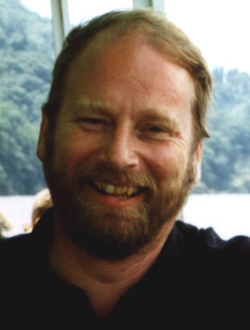Professor Edward L. “Ned” Wright
The New York Times article Gauging Age of Universe Becomes More Precise said
“The universe is 13.73 billion years old, give or take 120 million years, astronomers said last week.That age, based on precision measurements of the oldest light in the universe, agrees with results announced in 2006. Two additional years of data from a NASA satellite known as the Wilkinson Microwave Anisotropy Probe have narrowed the uncertainty by tens of millions of years.
Astronomers can also now see strong evidence for the universe being awash in almost massless subatomic particles known as neutrinos. This sea of primordial neutrinos created in the Big Bang was expected.
‘The new result is that it’s not consistent with zero anymore,’ said Edward L. Wright, a professor of physics and astronomy at the University of California, Los Angeles, and another member of the team.”
Edward L. “Ned” Wright, Ph.D., FAAAS is Professor of Physics and Astronomy at UCLA.
Ned is interested in infrared astronomy and cosmology. He is the PI on the Wide-field Infrared Survey Explorer (WISE) Midex proposal, which used to be called NGSS. He has been working on the COsmic Background Explorer (COBE) since 1978. In 1992 he received the NASA Exceptional Scientific Achievement Medal for his work on the Cosmic Background Explorer. The COBE team received the Gruber Prize in Cosmology in 2006. He is an Interdisciplinary Scientist on the Space InfraRed Telescope Facility (now the Spitzer Space Telescope) Science Working Group. He has worked on the Spitzer project since 1976.
Ned authored Comparing the NEATM with a Rotating, Cratered Thermophysical Asteroid Model, Constraints on Dark Energy from Supernovae, Gamma Ray Bursts, Acoustic Oscillations, Nucleosynthesis and Large Scale Structure and the Hubble constant, A Cosmology Calculator for the World Wide Web, Comparing Optical and Near Infrared Luminosity Functions, DIRBE Minus 2MASS: Confirming the Cosmic Infrared Background at 2.2 Microns, Angular Power Spectra of the COBE DIRBE Maps, Scanning and Mapping Strategies for CMB Experiments, and A Century of Cosmology. Read the full list of his publications!
He has studied fractal dust grains which are able to absorb and emit efficiently at millimeter wavelengths, and thus may be an important factor in studies of the cosmic microwave background. From 1994 to 1998, he served as Science Editor of The Astrophysical Journal. In 1995 he was named the CSEOL Distinguished Scientist of the Year.
Ned is also working on the Wilkinson Microwave Anisotropy Probe (WMAP). WMAP is a mission to follow-up the COBE discovery of fluctuations in the early Universe. It will observe the structure of the Universe 300,000 years after the Big Bang with better angular resolution than the COBE mission, and thus be able to detect the seeds of present day superclusters of galaxies. WMAP was launched on June 30, 2001 and released its first year of data in February 2003.
He earned his ABscl in Physics at Harvard in 1969 and Ph.D. in Astronomy at Harvard in 1976. In 2004 he was elected as a Fellow of the American Association for the Advancement of Science, and in 2007 he was elected as a Fellow of the American Academy of Arts and Sciences.
Read his Cosmology Tutorial and Relativity Tutorial.
